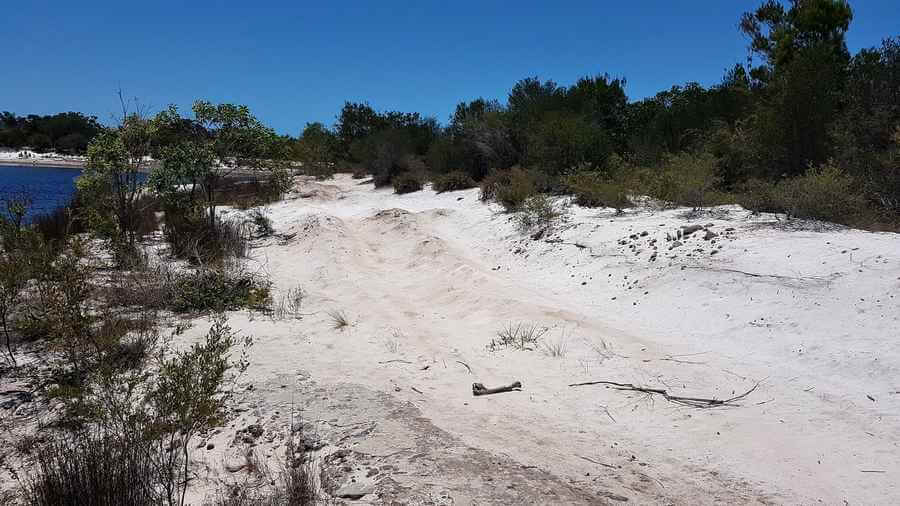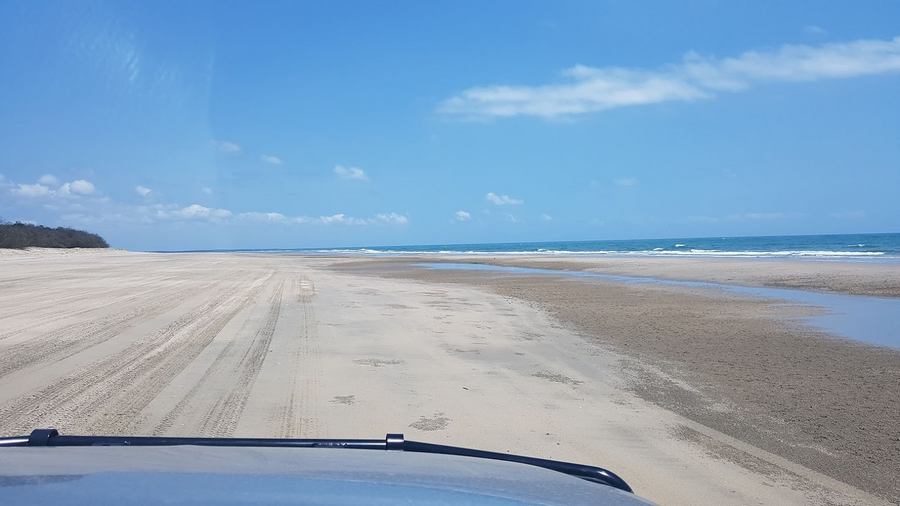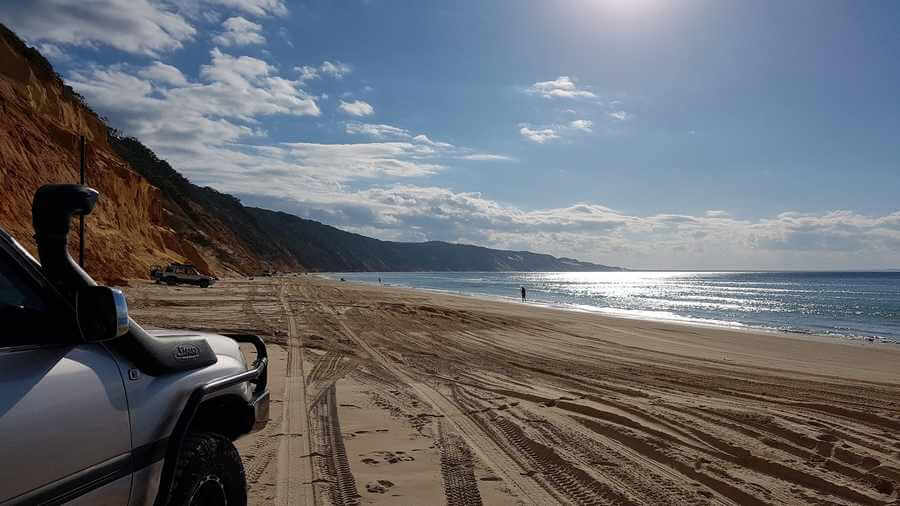Beaches are idyllic hubs for a variety of activities. From fishing, swimming, boating, etc, the possibilities are practically endless. This is particularly true for Australian beaches where stretches of white or golden sands line the coastlines.
These beaches can be found on the mainland of Australia as well as the many islands just off the shores.
Yes, you need a proper 4WD to drive on the beach, Not an AWD as they don’t offer a low range gearbox without this you’re limited in areas you access, Hire a 4WD that has axels that move simultaneously to tackle the rough beach terrain.
Australia is a country with varied terrain including rocky areas, beaches, mangroves, rainforest, etc. Due to the varying types of terrain, it may be necessary to drive a 4WD
Moreover, 4WD is an activity that Australians find really thrilling. It is a common pleasure that Australians do, from beaches to beyond.
Driving on the beach with a 4WD is not only exciting but a great way to really get immersed in the beach atmosphere.
Between the sunshine, the sea air and the sounds of rolling waves, there are many benefits to driving on the beach with a 4WD.
Some places in Australia do require driving a 4WD for access to certain beach areas. Once again, this is due to the terrain that simply cannot be reached with regular vehicles.
One of the most notorious places in Australia for driving on the beach with 4WD is 75 Mile Beach on Fraser Island, as well as Fraser Island itself. This is because Fraser island and its shorelines are really sandy areas that impassable by regular vehicles.
Driving 4WD vehicles on the beach in Australia may be well a favourite pastime for most residents but even tourists or visitors can take part in the action!
There are 4WD rentals available, especially when heading to Fraser Island

How Do You Drive A 4WD On The Beach?
Driving may come naturally for some but there are always some tips to consider. This is especially true for 4WD driving. Because a 4WD vehicle has axels that move at the same time, it is important to consider how the vehicle stops, if needed.
It is also important to know how to handle the vehicle overall. This can include tips for driving along the beach in general! Below are some of the best tips for making the most out of a 4WD experience on the beach in Australia!
8 Tips For Driving A 4WD On The Beach In Australia
Only Drive On The Beach At Low Tide!
This is one of the most important aspects of driving a 4WD on the beach. The waters surrounding Australia, especially some of the islands like Fraser Island, can get pretty violent.
This can result in high tides that make it pretty far onto the mainland. If you’re driving along the beach during high tide, there is a very large chance you can get swept away in a tide. Always practice safety first and only drive during low tide times. This absolutely ensures the best driving experience!
Choose The Right Vehicle For 4WD In The Sand.
Most 4WD driving can be accomplished with some forms of SUV vehicles. however, it is more practical to have a vehicle that is proper clearance. This means that the vehicle will have enough space between the bottom of the 4WD and the terrain in which is it driving.
This is important because areas with more jutting rocks, etc can cause some damage to the undercarriage of the vehicle. Moreover, it can cause vehicles to drag and ultimately reduce speed. One of the most fun things about 4WD driving is having a little speed!
Ensure There Are Good Sand Tyres On The Vehicle!
Sand tires are the best for heading out for beach 4WD driving as the traction on the tread is best suited to sand. It is suggested that driving on the beach with a 4WD is done on the hard, wet sand.
Softer sands can cause these vehicles to get jammed up. While it is tempting to use the pre-setting of “traction control“, it actually will inhibit the axels from moving properly.
Having free range motion of these axels and a good set of sand tyres is the best way to drive a 4WD drive on the beach.
Make Sure The Right Gear Is Being Used
A huge part of 4WD driving is manual driving or the use of changing gears. This is the power behind the fun of driving on the beach while in a 4WD vehicle. It is important to make sure that the right gear is being used as this will make going up small sand dunes, etc more accessible.
Not everyone is experienced in driving a gear-shift engine. In this case, there are auto gearboxes where the vehicle can sense the need for changing gears. These are perfect for more inexperienced drivers.
Practise Makes Perfect When Changing Gears!
For those who may know a little bit about gear-shift driving but aren’t necessarily comfortable doing it, practise truly makes perfect. It is suggested that starting out on small sanded areas to get the feel for driving with a 4WD is suggested.
This is so important because sand is really unpredictable. It is very pliable meaning it changes form constantly. Because of this, a little practise manoeuvring around the sand can really aid the overall control of the vehicle.
Travel Lightly Less Weight Helps From Getting Stuck
Bringing too much on a trip for 4WD driving can really slow down the vehicle. While there are some basic necessities, there is no need to go overboard.
The fun behind beach 4WD driving is in the speed, yes, but more so, it is in the momentum that will carry the vehicle more naturally. Having a lighter load on board will aid in this momentum build up!
Lower The Tyre Pressure For Better Grip
Tyre pressure is important in the type of driving that is being done. For regular road driving, higher tyre pressure is needed to ensure that smooth driving and safe driving can occur.
When it comes to 4WD beach driving, the opposite is true! Lowering the tyre pressure will make the tyres easier to move through sand ruts. Yes, good sand tyres will have the right traction treads on them but the lowering of the pressure is necessary as well.
It is suggested to use somewhere between 18 to 20 PSI but never go below 18 as the risk of a flat tyre can occur.
Always Follow Basic Road Rules To Be Safe
Sure, driving on the beach with 4WD is a great way to let loose and have some fun! However, the basic road rules should still be followed. Always be on the lookout for animals or people in the path of which you’re driving.
Ensure to use the brakes properly. Never break too slow or slam on the brakes unless it’s absolutely necessary. Following basic road rules will keep safety at the forefront!
These tips are a great way to enjoy beach driving with a 4WD vehicle. These tips can apply to pro-drivers and novice drivers alike!
Can A 4WD Get Stuck On The Beach?
Driving a 4WD on the beach is a lot of fun but as with any activity, being prepared is essential! It is possible to get stuck on the beach in a 4WD vehicle. This is mainly due to the ever-changing nature of the sand. Between the tides rolling in and various weather conditions, the sand can become deep ruts, creating sand traps. Sure 4WD vehicles are meant to handle rough terrain, however, getting stuck is bound to happen.
While a 4WD can get stuck on the beach, it is critical to have the gear to help remove a stuck vehicle. While is recommended to travel light, this is the gear that should absolutely be brought along. It is often referred to as “recovery gear“. Below is the type of gear to bring along while driving on the beach with a 4WD!

Recovery Gear To Bring When Going 4WD
- Shovels – to dig sand out from beneath the tyres.
- Snatch-straps – to possibly pull the vehicle out.
- Tyre deflator – in case the tyres need to be deflated more.
- Maxtrack – if this is an affordable option, these are a great tool. They are designed to put under tyres to help roll them out of stuck spots.
This list can be altered to include other items, however, these are the absolutely essential things to pack. Anything can happen, especially in Australia, so being a little prepared never hurts. Driving on the beach with 4WD can be a lot of fun and having some great tips and advice to make the best of the adventure is wonderful!
More Pages On Beaches
Not all beaches are suitable for swimming for a number of reasons. Some of these areas are more practical for sand activities or photography. It is important to know whether or not a beach is safe...
Visiting the beach is a beautiful opportunity to see mother nature at its best. There's nothing quite like hearing the waves rolling in on a soft, sandy shoreline. While visiting the beach is a...



